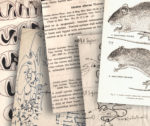Laelapid mites (Mesostigmata) ectoparasites of Oligoryzomys (Rodentia: Cricetidae) in north-eastern and central Argentina
Ekaterina Savchenko, Mauricio Melis, Marcela LareschiLaelapidae mites are distributed throughout the world and include many species that are common parasites of cricetid rodents. Although knowledge of the host associations of laelapids is well recorded for the Oligoryzomys species in Buenos Aires province in Argentina, this information is scarce or null for other regions of the country and for some species of this genus. Here we report new records of laelapid mites associated with Oligoryzomys flavescens, O. fornesi and O. nigripes, obtained during collections carried out for more than a decade in north-eastern and central Argentina, covering a wide geographic range that includes sympatric sites for these rodents. Herein, laelapids associated with these rodents are reported for the first time in the provinces of Chaco and Formosa; and also for the first time records of laelapids in O. fornesi. All three rodent species are associated with the laelapids Androlaelaps fahrenholzi, Gigantolaelaps wolffsohni, Mysolaelaps microspinosus and Mysolaelaps parvispinosus. Laelaps schatzi is reported only for O. flavescens and O. fornesi, while Laelaps paulistanensis was exclusive to O. nigripes, regardless of locality. The results support the view that species reflect the distribution of each host, with the exception of M. parvispinosus. Information on the distribution of ectoparasites and their hosts is relevant to many biological questions, especially when the host and/or the ectoparasite play an important role in the transmission of pathogens of public health importance.
Ácaros laelápidos (Mesostigmata) ectoparásitos de Oligoryzomys (Rodentia: Cricetidae) en el noreste y centro de la Argentina. Los ácaros Laelapidae están distribuidos en todo el mundo e incluyen muchas especies que son parásitos comunes de los roedores cricétidos. Si bien el conocimiento de las asociaciones hospedatorias de los lelápidos está bien registrado para las especies de Oligoryzomys en la provincia de Buenos Aires de la Argentina, esta información es escasa o nula para otras regiones del país y para algunas especies de este género. Aquí reportamos nuevos registros de ácaros lelápidos asociados a Oligoryzomys flavescens, O. fornesi y O. nigripes, obtenidos durante colectas llevadas a cabo durante más de una década en el noreste y centro de la Argentina, cubriendo un amplio rango geográfico que incluye sitios de simpatría de estos roedores. Se mencionan por primera vez lelápidos asociados a estos roedores en las provincias de Chaco y Formosa, y también por primera vez registros de lelápidos en O. fornesi. Roedores de las tres especies se registran asociados a los lelápidos Androlaelaps fahrenholzi, Gigantolaelaps wolffsohni, Mysolaelaps microspinosus y Mysolaelaps parvispinosus. Laelaps schatzi solo se reporta para O. flavescens y O. fornesi, mientras que Laelaps paulistanensis fue exclusivo de O. nigripes, independientemente de la localidad. Los resultados apoyan que todas las especies reflejan la distribución de cada hospedador, con la excepción de M. parvispinosus. La información actualizada sobre la distribución de los ectoparásitos y de sus hospedadores es relevante para muchas cuestiones biológicas, especialmente cuando el hospedador y/o el ectoparásito juegan un papel importante en la transmisión de patógenos con importancia sanitaria.
